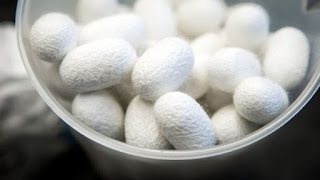Coldengham, New York
Store of Cadwallader Colden, Jr.
Silk
Arthur McKinney purchased four skeins of silk from the Colden Store on this day, 250 years-ago.
The 'silk' described here is believed to be silk thread. Webster defined silk in his 1828 dictionary as:
"The fine soft thread produced by the insect called silk-worm or bombyx. That which we ordinarily call silk is a thread composed of several finer threads which the worm draws from its bowels, like the web of a spider, and with which the silk-worm envelopes itself, forming what is called a cocoon."
 |
| Silk cocoons. Image courtesy of geek.com |
Webster's alternate definition for 'silk' was the cloth made of silk fibers.
==============================
Search the DayBook
This article is one in a series of a daily accountings of Colden Store transactions. Be sure you read the first installment for an introduction to the store. You should also read this article which appeared in the Journal of the Orange County Historical Society.
===============================
When Colden used the term 'thread' in the DayBook he was referring to linen thread. For example, 'thread' sold to the store by local artisans was undoubtedly linen. That happened on two occasions.
The term 'silk' implied a thread as stated by Webster above, but it was never referred to as 'silk thread' as that must have been thought of as being redundant.
The price per skein of 'silk' was much higher than all of the prices for skeins of 'thread.' In other words, silk thread was more valuable than linen thread.
The DayBook made over 200 mentions of silk. Just about all of them referred to silk thread as they were sold by the skein. On one occasion he sold 'silk' by the yard (see notes on silk fabrics below) and on about ten occasions he used 'silk' to describe a finished item, such as a Cravat, a Camblet, a Stocking, or a Handkerchief.
All silk fabrics were referred to by their 'brand' names and did not contain the descriptor of 'silk'. For example, Persian, Taffity, Crape, Plush, Poplin, Alamode, and Gimp were all fabrics made of silk.
===============================
Search the DayBook
No comments:
Post a Comment